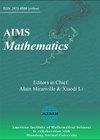Pythagorean fuzzy incidence graphs with application in illegal wildlife trade
IF 1.8
3区 数学
Q1 MATHEMATICS
引用次数: 0
Abstract
Chemical engineers can model numerous interactions in a process using incidence graphs. They are used to methodically map out a whole network of interconnected processes and controllers to describe each component's impact on the others. It makes it easier to visualize potential process paths or a series of impacts. A Pythagorean fuzzy set is an effective tool to overcome ambiguity and vagueness. In this paper, we introduce the concept of Pythagorean fuzzy incidence graphs. We discuss the incidence path and characterize the strongest incidence path in Pythagorean fuzzy incidence graphs. Furthermore, we propose the idea of Pythagorean fuzzy incidence cycles and Pythagorean fuzzy incidence trees in Pythagorean fuzzy incidence graphs and give some essential results. We illustrate the notions of Pythagorean fuzzy incidence cut vertices, Pythagorean fuzzy incidence bridges, and Pythagorean fuzzy incidence cut pairs. We also establish some results about Pythagorean fuzzy incidence cut pairs. Moreover, we study the types of incidence pairs and determine some crucial results concerning strong incidence pairs in the Pythagorean fuzzy incidence graph. We also obtain the characterization of Pythagorean fuzzy incidence cut pairs using $ \alpha $-strong incidence pairs and find the relation between Pythagorean fuzzy incidence trees and $ \alpha $-strong incidence pairs. Finally, we provide the application of Pythagorean fuzzy incidence graphs in the illegal wildlife trade.毕达哥拉斯模糊关联图及其在野生动物非法贸易中的应用
化学工程师可以使用关联图对一个过程中的许多相互作用进行建模。它们被用来系统地绘制出一个由相互连接的过程和控制器组成的整个网络,以描述每个组件对其他组件的影响。它可以更容易地可视化潜在的过程路径或一系列影响。毕达哥拉斯模糊集是克服模糊性和模糊性的有效工具。本文引入了毕达哥拉斯模糊关联图的概念。讨论了毕达哥拉斯模糊关联图中的关联路径,并刻画了最强关联路径。在此基础上,提出了毕达哥拉斯模糊关联图中的毕达哥拉斯模糊关联圈和毕达哥拉斯模糊关联树的概念,并给出了一些重要结果。我们说明了毕达哥拉斯模糊关联切顶点、毕达哥拉斯模糊关联桥和毕达哥拉斯模糊关联切对的概念。建立了关于毕达哥拉斯模糊关联切对的一些结果。此外,我们还研究了关联对的类型,并在毕达哥拉斯模糊关联图中确定了一些关于强关联对的关键结果。我们还利用$ \alpha $-强关联对得到了勾股定理模糊关联切对的刻画,并找到了勾股定理模糊关联树与$ \alpha $-强关联对之间的关系。最后,给出了毕达哥拉斯模糊关联图在野生动物非法贸易中的应用。
本文章由计算机程序翻译,如有差异,请以英文原文为准。
求助全文
约1分钟内获得全文
求助全文
来源期刊

AIMS Mathematics
Mathematics-General Mathematics
CiteScore
3.40
自引率
13.60%
发文量
769
审稿时长
90 days
期刊介绍:
AIMS Mathematics is an international Open Access journal devoted to publishing peer-reviewed, high quality, original papers in all fields of mathematics. We publish the following article types: original research articles, reviews, editorials, letters, and conference reports.
 求助内容:
求助内容: 应助结果提醒方式:
应助结果提醒方式:


